#global seed vault
Explore tagged Tumblr posts
Text

Svalbard Global Seed Vault
Inside this building is 13,000 years of agricultural history. Essentially a huge safety deposit box, holding the world’s largest collection of agricultural biodiversity. Opened in 2008.
“There are big and small doomsdays going on around the world every day. Genetic material is being lost all over the globe,” says Marie Haga, executive director of the Crop Trust.

2017 - But soaring temperatures in the Arctic at the end of the world’s hottest ever recorded year led to melting and heavy rain, when light snow should have been falling. The end of 2016 saw average temperatures over 7C above normal on Spitsbergen, pushing the permafrost above melting point. A lot of water went into the start of the tunnel and then it froze to ice, so it was like a glacier when you went in. The vault was supposed to operate without the help of humans, but now must be monitored 24 hours a day. The breach has questioned the ability of the vault to survive as a lifeline for humanity if catastrophe strikes.
The vault managers are now taking precautions, including major work to waterproof the 100m-long tunnel into the mountain and digging trenches into the mountainside to channel meltwater and rain away. They have also removed electrical equipment from the tunnel that produced some heat and installed pumps in the vault itself in case of a future flood.
“We have to find solutions. It is a big responsibility and we take it very seriously. We are doing this for the world.”
“This is supposed to last for eternity,” said Åsmund Asdal at the Nordic Genetic Resource Centre, which operates the seed vault.
2024 - Daniel Brooks co-author of A Darwinian Survival Guide uses the Seed Vault as an analogy for preparing for the coming years.
"The place where it is was chosen because it was thought that it was going to be cold forever, and everything would be fine, and you could store all these seeds now. And now all the area around it is melting, and this whole thing is in jeopardy. This is a really good example of letting engineers and physicists be in charge of the construction process, rather than biologists. Biologists understand that conditions never stay the same; engineers engineer things for, this is the way things are, this is the way things are always going to be. Physicists are always looking for some sort of general law of in perpetuity, and biologists are never under any illusions about this. Biologists understand that things are always going to change."
Me: I'm digesting information and I don't quite know yet how to talk about my thought feelings. Change to our biosphere is rolling in faster than these intelligent people thought it would. Wildfire in the Arctic circle! Extreme weather. Ice melt. Social instability.
source: Time source: Guardian source: MIT Press Reader
1 note
·
View note
Text
#american bison#anthropocene#arctic#australia#biodiversity#biodiversity loss#biorepository#bison#candice gaukel andrews#climate change#cryopreservation#cultures#currency#environment#global seed vault#global warming#money#moon#natural habitat adventures#nathab#nature#norway#permafrost#predators#ravens#science#science and environment#scientific research#svalbard#wild
0 notes
Text
Two men who were instrumental in creating a global seed vault designed to safeguard the world's agricultural diversity will be honoured as the 2024 World Food Prize laureates.
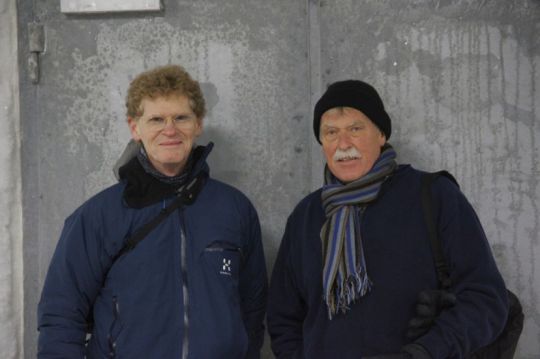
Cary Fowler, the US special envoy for Global Food Security, and Geoffrey Hawtin, an agricultural scientist from the UK and executive board member at the Global Crop Diversity Trust, will be awarded the annual prize and split a $500,000 (€464,000) award. In 2004, Fowler and Hawtin led the effort to build a backup vault of the world's crop seeds in a place where it could be safe from political upheaval and environmental changes.
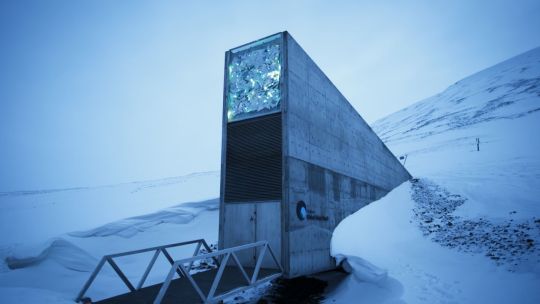
The facility was built into the side of a mountain on a Norwegian island in the Arctic Circle where temperatures could ensure seeds would be preserved.
The Svalbard Global Seed Vault - also known as the 'Doomsday vault' - opened in 2008 and now holds 1.25 million seed samples from nearly every country in the world.
#solarpunk#solar punk#indigenous knowledge#community#reculture#seed vault#svalbard#global food prize#preserving the future
158 notes
·
View notes
Text
I'm rewatching Exu: Calamity and I think they made a mistake with the name. The real title should be Exu: Actually, Vasselheim has good reasons for how it operates, even if they're dicks about it sometimes. Maybe it was too long, so they went with the snappier CALAMITY! Instead lol.
The end of the Calamity was only 840 something years ago. With Elves and dragons running around, some of them are definitely old enough where, if they didn't live during the Age of Arcanum themselves, their parents or grandparents would have and they would have been told a thousand stories of the fuck heads in flying cities who destroyed the world and were super annoying and dangerous long before they did that. Many more would be born during the latter part of the Calamity or raised by people who survived the Calamity who passes on those stories. Depending on the race we are talking anywhere from direct witnesses (Like the Bright Queen and Ludinus) to like 2-5 generations removed. Even humans with our short lifespans, it's really not THAT long, especially if you've got a bunch of old ass elves around teaching history class from a first person pov for like 500 years lol.
Intellectually people know that Critical Role, the world of Exandria is a post apocalypse story. Exandria is a scarred landscape that is just beginning to bounce back from the brink. But because it is recovering, it's easy to forget sometimes that it IS POST APOCALYPTIC. So people looking at Vasselheim in the modern day are like, 'bro, you really need to chill, everything's fine.' And Vasselheim is like... 'Chill? I do not understand the meaning of this word. And everything is fine... for now. We will be a bastion of civilization when the end times come once more. Fare thee well traveler.'
Then everyone rolls their eyes and moves on with their day. But if you really think about Vasselheim's isolationism and strength and distain for arcane magic in historical context, you can't really blame them. Are they over the top about their dislike of arcane magic? Sure. Is it quite possibly the most understandable over reaction in the history of over reactions? Also yes! They haven't made it illegal, they are just going to keep an eye on you, so you don't pull a Vespin Chloras and doom the planet to another few centuries of choked skies and sundered landscapes, that's all. Vespin was IN Vasselheim! Of COURSE they have strong feelings about it. The (Almost) End of the World began in Vasselheim due to arcane magic. If they had been stricter, maybe it wouldn't have happened at all!
And it really does paint their actions in Campaign 1 in a different light as well. Their isolationism can come across as shortsighted and selfish, until you view it from their point of view. Which is that they are constantly under threat, they know for a fact that Asmodeus wants their city destroyed, they are a bastion for the Prime Deities in a world filled with many heathens (lol that's where the dickishness comes in) and the Betrayer Gods would take any sign of weakness in their defenses and attack with glee. Hearing it in C1 it sounds like an excuse not to help against the Chroma Conclave, but it is literally just the truth from what I can tell. In BOTH Calamity and Downfall they have mentioned destroying Vasselheim being on the Betrayer God's to do list lol. If I was on a Betrayer God's to do list specifically, by name, I too would be somewhat paranoid and would not really want to disarm any portion of the city to go do something else. No matter how important the something else might be.
Vasselheim was basically like; Look, I'm very sorry to hear about your Dragon problem, that sucks, truly, but if we go out all willy nilly and leave this city undefended, it'll be fucked when we get back. When you have a real plan, come back and get us and we'll join you for the big fight. Until then, it's up to you, here you can have Kima as well, she's been desperate to get out of here anyway, and here's some supplies. We have larger concerns than one continent being attacked by four ancient Dragons. We are the seed bank for civilization for when shit inevitably hits the fan. We are the doomsday bunker for the Apocalypse, four Ancient Dragons are terrible, but they are not the Apocalypse. And they are right. Looking at it all in context, The Chroma Conclave are small potatoes. Horrific, monstrous, life destroying, but compared to the threat Vasselheim is preparing for, nothing.
They are the doomsday preppers of Exandria, except the threat is real and they are only letting their collective trauma and ptsd inform their decisions a little bit. They are actually fairly rational all things considered. This city withstood the entire Calamity. The stewards of the city must feel an enormous weight and responsibility to keep it safe going into the future. Imagine the pressure. Are you going to be the one to fuck it all up, after thousands of years? Sounds like a nightmare to me. The level of devotion and conviction required to keep something like that going is incredible.
#critical role#exu calamity#vasselheim#the bright queen#ludinus da'leth#vespin chloras#exu downfall#Svalbard Global Seed Vault#chroma conclave#campaign 1#vox machina#exandrian pantheon#prime deities#betrayer gods#divine magic#arcane magic#post apocalypse#generational trauma#long lives#responsibility#difficult choices#constant threats#critical role spoilers
75 notes
·
View notes
Text

170 notes
·
View notes
Text
The land where the sun doesn’t rise! 😵
Svalbard, Norway
📹: g_cooper
NOTE:
Polar Night — the period where the sun doesn't rise above the horizon in the Arctic.
18 notes
·
View notes
Text

Svalbard Global Seed Vault
The Svalbard Global Seed Vault is a secure seed bank located on the Norwegian island of Spitsbergen, near Longyearbyen. It was established in 2008 as a global backup facility to preserve and protect the world's crop diversity in case of regional or global catastrophes.
Often referred to as the "Doomsday Vault," the seed vault is built into a mountainside and designed to withstand natural and human-made disasters, including earthquakes and nuclear war. It is situated in the permafrost, providing natural cooling and preserving the seeds at a constant low temperature.
The purpose of the seed vault is to safeguard the world's agricultural heritage and ensure the availability of diverse plant genetic resources for future generations. The vault acts as a repository, storing duplicate seed samples from gene banks around the world. These samples represent a wide range of important food crops and plant species.
The seed vault currently holds over one million different seed samples, with the capacity to store up to 4.5 million samples. It serves as a long-term insurance policy for global food security, as it allows for the reestablishment of crops in the event of a major regional or global catastrophe.
The Svalbard Global Seed Vault is an important international initiative, symbolizing the collective efforts to safeguard the world's agricultural heritage and ensure the resilience of food systems.
Read more
#wikipedia#weird facts#weird history#strange facts#strange history#random fact#weird wikipedia#wikiweird#Svalbard Global Seed Vault#doomsday#bunker
50 notes
·
View notes
Text
youtube
Deep in the drylands of Morocco, a hidden vault holds the seeds that could save humanity.
Climate change is changing our planet in tangible ways. Wildfires are blazing across the American West with unusual extremity, sea levels are rising at unprecedented rates, and some countries are recording their hottest summers on record.
What remains to be seen is how climate change will affect the future of the global food supply.
That's why scientists in Morocco are building one of the world’s largest collections of seeds — a vault that may hold the key to future-proofing crop production and, potentially, our survival.
#freethink#solarpunk#Morocco#plants#seeds#crops#climate change#climate crisis#climate collapse#climate chaos#global warming#global heating#wildfires#drought#seed vault#Youtube
2 notes
·
View notes
Link
The Svalbard Global Seed Vault
This 'doomsday' Arctic seed vault on Norway's Spitsbergen island is set to receive its most diverse batch of seed donations yet as efforts to secure the world's food supplies ramp up amid rising climate concerns.
read more from the reuters | 1 mar 2023
22 notes
·
View notes
Text
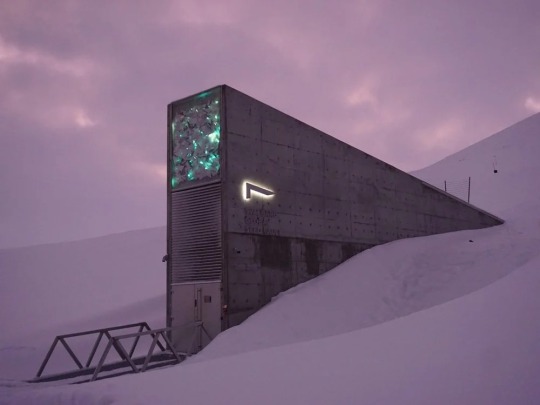
The Svalbard Global Seed Vault is located in the Norwegian Arctic on the remote island of Spitsbergen. Shaliz Barzani/Crop Trust
Take a Virtual Tour of the ‘Doomsday’ Seed Vault! The Impressive Depository Carefully Preserves Over One Million Seed Samples In Its Arctic Location
— Teresa Nowakowski, Staff Contributor | March 16, 2023 | Smithsonian Mag
In the frigid Norwegian Arctic, a gray wedge-shaped building protrudes from a mountain. Snow blows across the small metal bridge that leads to its entrance, above which a pattern of steel, mirrors and prisms reflect a ghostly green light. Large letters on the building’s side hint at the precious collection that’s held within, declaring that here is the entrance to the “Svalbard Global Seed Vault.”
Only a handful of people are allowed inside the vault, and its five metal doors are only opened a few times each year for new entries of seeds. But now, in honor of its 15th anniversary, you can catch a rare glimpse of the vault’s interior through a virtual tour.
Carved into Plateau Mountain on the Norwegian island of Spitsbergen, it holds more than 1.2 million seed samples from almost every country in the world, including recent first-time depositors Albania, Croatia, North Macedonia and Benin. Meant to protect crop biodiversity in case of localized catastrophe, this curious depository is often referred to as the “doomsday seed vault.”
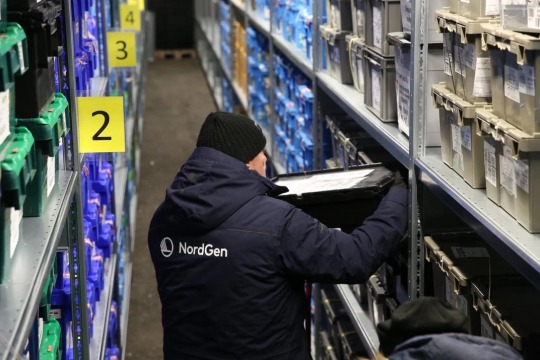
A member of NordGen, the gene bank of the Nordic countries, places a box of seeds in one of the vault chambers. Luis Salazar/Crop Trust
“From here in Svalbard, the world looks different. This seed vault represents hope, unity and security,” says Stefan Schmitz, executive director of the Crop Trust, a co-manager of the vault, in a press release. “In a world where the climate crisis, biodiversity loss, natural catastrophes and conflicts increasingly destabilize our food systems, it has never been more important to prioritize safeguarding these tiny seeds that hold so much potential to adapt our future food to such global threats.”
The contents of this doomsday vault are effectively backup storage for a global network of more than 1,700 smaller vaults called gene banks. Countries deposit copies of the seeds they hold in their own banks, and the Svalbard facility keeps them safe. This year, new seed deposits of wild strawberries, wheat, maize and rice have joined the ranks of other preserved plants. An organization from North Macedonia deposited seeds from an ajvarka red pepper variety used to make a popular traditional relish.
The seeds remain the property of the depositing country, to be withdrawn in the event their own stockpile is compromised. In 2015, for example, seeds from the vault were used to restart the International Center for Agricultural Research in the Dry Areas after its Aleppo seed bank had to be abandoned during the Syrian civil war.
To preserve its contents, the Arctic vault is protected by almost 400 feet of rock at its deepest point. Even virtually, its floor-to-ceiling shelves with the space for thousands of seed boxes are an impressive sight to behold.
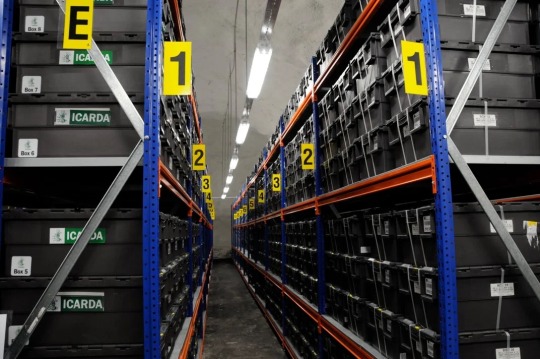
Shelves inside one of the seed vault's three chambers, each of which are capable of storing 3,000 samples. Mari Tefre/Global Crop Diversity Trust
“It is a bit like being in a cathedral. It has high ceilings and when you’re standing inside the mountain, there’s hardly any sound. All you can hear is yourself,” Lise Lykke Steffensen, executive director of NordGen, the gene bank of the Nordic countries that handles day-to-day operation of the vault, tells the Guardian’s Patrick Greenfield. “When you open the door, it’s minus 18 degrees Celsius—the international standard for conserving seeds—which is very, very cold. Then you see all of the boxes with seeds from all of these countries. I’ve been so many times and I’m still curious.”
Since its establishment in 2008, the vault’s collection has continued to grow. It is the largest global security reserve of seeds for food and feed crops, according to the Norwegian government.
In a tumultuous world where wars and extreme weather events wreak havoc, those who run the vault say it’s an important symbol of cooperation and global community.
“The seeds don’t care that there are North Korean seeds and South Korean seeds in the same aisle,” Brian Lainoff, the former lead partnerships coordinator of the Crop Trust, told Time’s Jennifer Duggan in 2017. “They are cold and safe up there, and that’s all that really matters.”
#The Svalbard Global Seed Vault#‘Doomsday’ Seed Vault#One Million Seed Samples#Arctic#Teresa Nowakowski#Norwegian 🇳��� Arctic
3 notes
·
View notes
Text
They should let me in the Svalbard seed vault I totally won't eat all the seeds what are they talking about I have no criminal record no I won't eat the seeds in the vault no I promise! I am now in the seed vault, legally or illegally is up to your imagination Yummuy. Se eds :)
#tw unreality#svalbard global seed vault#svalbard seed vault#my two favourite words are svalbard and vissen
0 notes
Text
A charitable trust, the Global Crop Diversity Trust, meets most of the operating costs through an endowment fund.
"Human Universe" - Professor Brian Cox and Andrew Cohen
#book quote#human universe#brian cox#andrew cohen#nonfiction#charitable trust#trust fund#global crop diversity trust#svalbard global seed vault#operating costs#endowment fund
0 notes
Text
my hungry ass could never work at the Svalbard Global Seed Vault
250 notes
·
View notes
Text
My thoughts on the best strategies to preserve human knowledge and creation in perpetuity
1) don't put all your eggs in one basket
archives need to be paper and digital, public and private sector, centralised and decentralised, fully legal / by the book and rogue, in vaults and cabinets and servers and torrents
create as many redundancies as you can: make copies, and copies of the copies, and copies of the copies of the copies, ad nauseam; anyone anywhere who can make copies, should
spread the physical hubs (paper stacks or servers) geographically, in as many places as possible; you never know what kind of natural disaster or man-made horror will take out a whole building, city, region, or continent tomorrow
2) entropy is a bitch, think longterm
pick methods that are more likely to last
schedule regular copying: you gotta transfer the stuff to a new medium before the old one falls apart, so have some idea when it's expected to fall apart
3) keep converting to new formats
no format becomes obsolete instantly, there's always a transition period; use transition periods to furiously convert everything
4) indexing and searching is as important as the content itself
self-explanatory
5) eyes on the prize: the end goal is public access
if a random nobody, with no status and no money, can't access it easily, freely, and anonymously, the job is only half-done; you've built the back-end and neglected the front-end; get someone to complete it ASAP, because now it's just sitting pretty and isn't doing anything; or isn't doing enough, in any case
bonus: use. fucking. torrents.
It is truly bonkers that the bittorrent protocol is not being used for archiving. It's an ideal method for digital archiving and it should be standard procedure. If a university has stuff on a hard disk, it can put it on its server, and if it can put it on a server, it can torrent it and seed it 24/7. If the same archive is useful for another university on the other side of the planet, that one can download it and then stay in the swarm, also seeding it. If a library or city council anywhere on earth finds the archive of interest, it can do the same. The more the merrier, every download is a potential redundancy and every seeder is an actual redundancy.
If you got space to store it, you got space to share it. And of course, any private individual can at any time join the swarm. So we get excellent preservation (with multiple redundancies, spread far and wide geographically) AND public access, global and free, which is what preservation is FOR in the first place! It ain't for the heck of it, it ain't only for the eyes of the elite, it's for everyone, that's the purpose, that's the end goal. If that's not your end goal, you're doing it wrong.
720 notes
·
View notes
Note
So how does BE’s simulation work? Is it like a big dome on the surface of the earth with like real plants and animals or are they fake? Also how big exactly is it and how many biomes does it have?
HELLO DEAR MUTUAL sorry for responding so late 🌞, had stuff to do from college,,
I promise I’ll depict it later visually (because I really want to) but BE’s simulation/nature works with a dynamic I mostly made up to fit the lore. Here’s some important info from the background before I explain:
Up in the moon, 34RTH units (the division BE belonged to) besides being used by HEL-102 as showcases for the highest “beauty standards” also were constantly put to training sessions to test their skills when taking care of living organic beings, since that was technically their future purpose once they settled back on Earth. You’d think they would use the actual seeds and animals they had stored in their vault, but HEL-102 being the greedy monarch he was wasn’t gonna let not even his own creations handle them. SO, he developed a system inside the 34RTH units that allowed them to project holograms to simulate real living plants or animals for them to take care of. Take in mind that these holograms weren’t alive, they were simply a reflection of the knowledge of natural processes 34RTH units had inside their data banks.
Now talking about BE’s nature: once BE had pretty much merged herself with a thousand robotic corpses down in AM’s complex (following the lore I had explained a while back), she also merged herself with the seed she had stolen from the moon’s vault and had it integrated into her systems. This allowed her to reflect actual living beings through holograms that could grow, interact with other real beings like BE’s survivors and undergo all natural processes with an actual mind of their own now. All of what BE creates still depends on her however, think of her as a core that fuels her own creations and if corrupted or low on energy, it directly affects them. Ik this seems like pulled out of nowhere because it technically was but since I liked the headcanon of AM being able to create bodies or puppets all controlled by him down on his complex, I wanted BE to be able to create independent minds. This was a short a explanation with probably excluded info but if you’d like a simpler description, just imagine the Earth’s surface turned into an actual Minecraft world where BE is in creative mode :P.
Answering your second question: I wouldn’t think of it as a dome, but BE is able to harden the atmosphere into one if she’d like to. BE manually purified the air thus I think one shouldn’t be necessary. And yeah you could say the plants and animals aren’t real since they aren’t organic, but they can still interact around with full sentience and act as a real one, they’re just big clumps of energy minding their own business.
Answering your third question: BE’s “territory” extends from the Earth’s atmosphere down to the lowest point life has ever reached. I definitely don’t have this info as developed yet but I think it’d be fun to indulge into both AM’s and BE’s territories by representing them thru a diagram of Earth’s layers. Regarding the biomes, I don’t think BE herself would’ve created a new one since her objective was to rebuild everything just as it was before the global massacre, so the number of existing biomes in her nature stays the same as the og nature. Nevertheless, her survivors (COUGH* probably Adam or Terry) most likely asked her to simulate a fantasy-like biome at least once just for shits and giggles.
As always if you or anyone has any specific questions I’ll gladly answer them. This mechanic is still a bit under construction so things might change later.

14 notes
·
View notes
Photo

Svalbard Global Seed Vault, Spitzbergen, Norway co-managed by the Norwegian Ministry of Foreign Affairs, the Crop Trust and NordGen, the Genebank of the Nordic Countries image credit: NordGen via: The Guardian click below the image to launch a new virtual tour to mark its 15th anniversary
334 notes
·
View notes